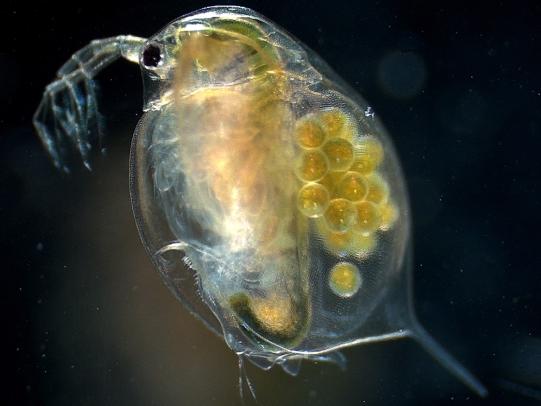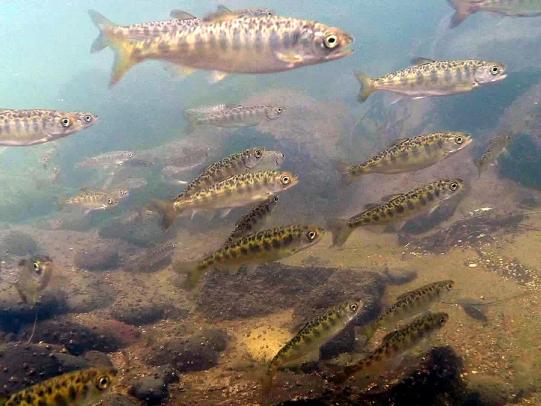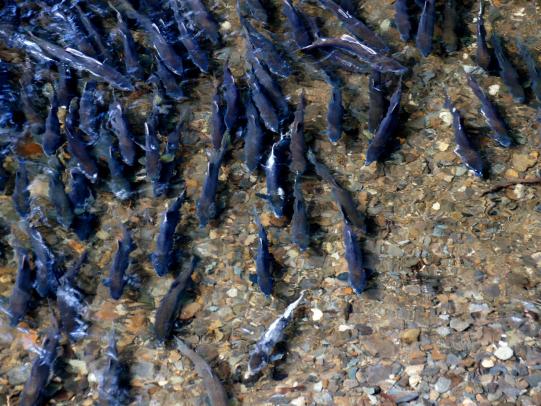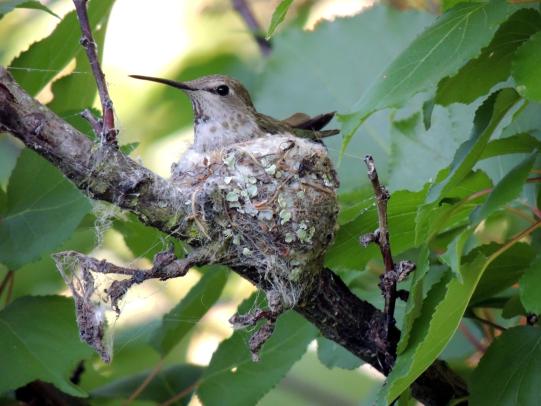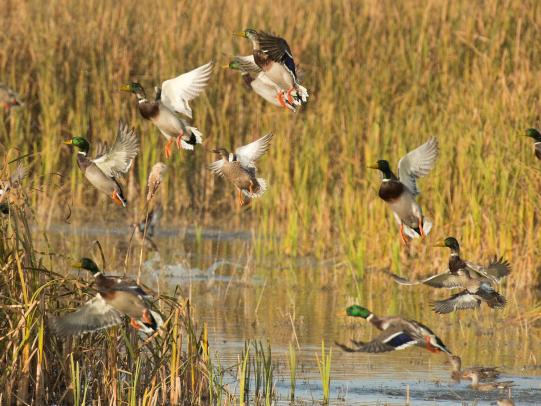UNDERSTANDING PESTICIDE LABELS TO PROTECT WILDLIFE
The photo shows ducks in a wetland. Pesticide products used on land in your garden and landscape can make their way into waterways. The chemicals in pesticides can harm wildlife and aquatic organisms if they are exposed to them.
What are Pesticides?
Pesticides are products designed to kill rodents, weeds, mosses, insects, plant diseases, slugs, and snails. Household disinfectants such as bleach and ammonia are considered pesticides. Flea-killer products are too.
JUMP TO
- Aquatic Organisms—Understand Pesticide Risks, What Labels Say & What It Means
- Fish—Understand Pesticide Risks, What Labels Say & What It Means
- Birds—Understand Pesticide Risks, What Labels Say & What It Means
Pesticide risk reduction tips
- Only use pesticides when necessary. Tolerate harmless pests.
- Minimize pest problems through good plant selection, installation, and ongoing care. By using the right watering, fertilizing, and sanitation practices, you should be able to prevent most serious plant problems.
- When applying a pesticide on land, take precautions to keep the spray or granules out of waterways. Use a combination of untreated buffer areas, vegetative strips, and non-chemical management near water.
- Store and dispose of pesticides properly to keep them away from wildlife. See How to Store Pesticides.
FOR QUESTIONS ABOUT PESTICIDES
The National Pesticide Information Center (NPIC) can answer questions about pest control chemicals.
1-800-858-7378 or npic@ace.orst.edu
Overview
- Chemicals in the environment, including pesticides, work their way up the food chain. They can harm wildlife such as fish and birds.
- The dose determines the poison for different animals. Tiny organisms can be harmed by small exposures to pesticides.
- Endangered salmon species rely on waterways throughout the Pacific Northwest for spawning habitat.
- Endangered birds like the Streaked Horned Lark are also at risk. Birds, fish, and mammals rely on smaller organisms for food.
Keys for Success
- Use information provided on pesticide labels to understand the risks of a product and how to apply it.
- Look for information about hazards to pollinators in the ENVIRONMENTAL HAZARDS section of the pesticide label.
- Follow the instructions to minimize risks.
- Follow the instructions to maximize benefits.
Weston Miller, Oregon State University
Our Top Tip
IF YOU HAVE TO USE POISON BAIT FOR RODENTS
Keep yourself, children, pets, and wildlife safe from harm by ALWAYS reading the entire label front to back. Review the instructions even for brands you know. It’s our best advice for your well-being.
Tips for Poison Baits
Use bait stations for rodenticides to reduce the risk of poisoning to children, pets, and wildlife by limiting access. Never leave loose bait unattended.
Poisoned rodents may be easy prey for pets and wildlife. If they eat enough, the predators may die.
Select rodenticides with cholecalciferol or bromethalin. They are less likely to harm predators compared to other products that contain more common ingredients, the anticoagulants.
See How to Get Rid of Mice and How to Get Rid of Rats for details about controlling rodents, including trapping methods.
- Look for the ENVIRONMENTAL HAZARDS section of the product label. It may be inside a booklet or pamphlet.
Look for the language below on the label:
- “To protect the environment, DO NOT allow pesticides to enter or run off into storm drains, drainage ditches, gutters, or surface waters.”
- “Applying this product in calm weather when rain is not predicted for the next 24 hours will help to ensure that wind or rain does not blow or wash pesticide off the treatment area.” This is a statement found on some pesticide labels.
WHAT THE LABEL SAYS & WHAT THAT MEANS FOR AQUATIC ORGANISMS
- Do you want to interpret language that you see on a pesticide label?
- Learn what the information about aquatic organisms on pesticide labels means.
What the Label Says: “This product is toxic to aquatic organisms.”
What That Means: This means the product contains an active ingredient that kills 50% of aquatic invertebrates (tiny organisms with no backbone) exposed to 1 ppm (part per million) of the pesticide in water. That’s highly toxic! One ppm is a very small amount, similar to one minute in two years, or one inch in 16 miles.
What if there is no mention of aquatic organisms? That doesn’t mean the product is harmless.
It means that more than 1 ppm is required to kill 50% of tested populations of aquatic invertebrates. Even two ppm is a very small amount, like two minutes in two years, or two inches in 16 miles.
- Look for the ENVIRONMENTAL HAZARDS section of the product label. It may be inside a booklet or pamphlet.
- To protect the environment, DON’T allow pesticides to enter or run off into storm drains, drainage ditches, gutters, or surface waters.
- “Applying this product in calm weather when rain is not predicted for the next 24 hours will help to ensure that wind or rain does not blow or wash pesticide off the treatment area.” This is a statement you may see on pesticide labels.
- When applying a pesticide on land, take precautions to keep the spray or granules out of waterways.
- Use a combination of untreated buffer areas, vegetative strips, and alternative methods near water. See How to Keep Pesticides Out of Waterways.
WHAT THE LABEL SAYS AND WHAT THAT MEANS FOR FISH
- Do you want to interpret language that you see on a pesticide label?
- Learn what the information about fish on pesticide labels means.
What the Label Says: “This product is toxic to fish.”
What That Means: This means the product contains an active ingredient that kills 50% of fish exposed to 1 ppm (part per million) of the pesticide in water. That’s highly toxic! One ppm is a very small amount, similar to one minute in two years, or one inch in 16 miles.
What the Label Says: “This product is extremely toxic to fish.”
What That Means: This means the US EPA is aware of actual incidents—fish fatalities—involving this product. The DIRECTIONS FOR USE section of the label will describe specific, required actions to prevent runoff into fish-bearing streams.
What if there is no mention of fish? That doesn’t mean the product is harmless to fish.
It means that more than 1 ppm is required to kill 50% of tested fish populations. Even two ppm is a very small amount, comparable to two minutes in two years, or two inches in 16 miles.
- Look for the ENVIRONMENTAL HAZARDS section of the product label. It may be inside a booklet or pamphlet.
- Pesticides can harm birds directly and indirectly.
- The effects may be lethal, or sublethal. Sublethal effects can include stress, illness, and changes in behavior.
WHAT THE LABEL SAYS AND WHAT THAT MEANS FOR BIRDS
- Do you want to interpret language that you see on a pesticide label?
- Learn what the information about birds on pesticide labels means.
What the Label Says: “This product is toxic to birds.”
What That Means: This means the product contains an active ingredient that killed 50% of birds who ate less than 100mg of pesticide per kilogram of their body weight. Songbirds often weigh less than 3 ounces, so a fatal dose might be as small as three-hundredths of an ounce, or less than one gram. That’s highly toxic.
What the Label Says: “This product is extremely toxic to birds.”
What That Means: This means the US EPA is aware of actual incidents—bird fatalities—involving this product. The active ingredient killed at least 50% of birds who ate less than 100mg of pesticide per kilogram of their body weight. That’s highly toxic.
What if there is no mention of birds? That doesn’t mean the product is harmless to birds.
It means that more than 1 gram is required to kill most birds that weigh about 3 ounces. Some species are more sensitive than others.
Content provided by Kaci Buhl and Weston Miller.
Peer reviewed by OSU Department of Horticulture.
PESTICIDES AND WILDLIFE REFERENCES
Tips for Reducing Pesticide Impacts on Wildlife
US Environmental Protection Agency
Would I Hurt the Fish by Weeding and Feeding the Lawn?
National Pesticide Information Center
Ecotoxicology
National Pesticide Information Center
Pesticides and Residential Soils
National Pesticide Information Center
